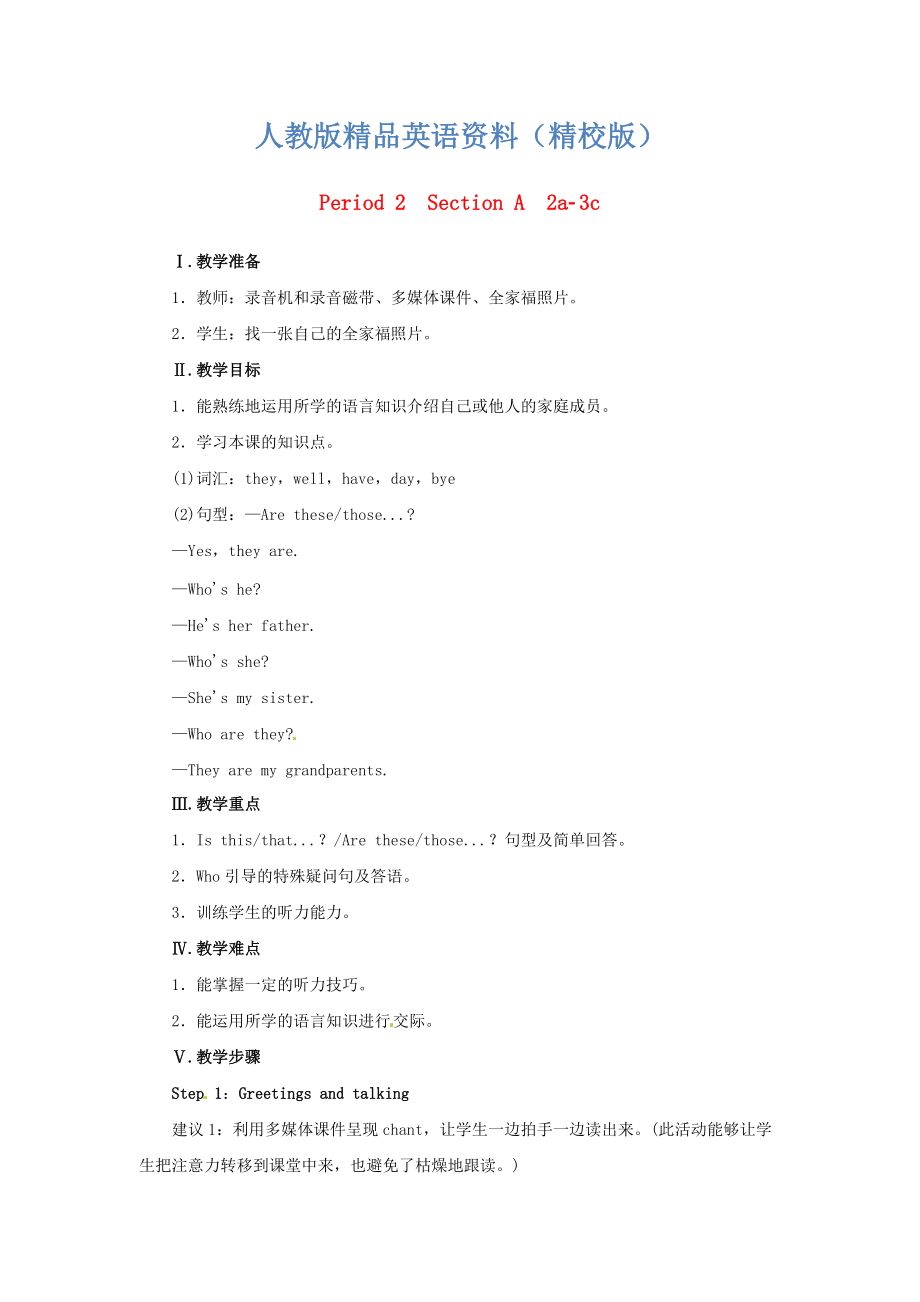《【精校版】【人教版】七年級英語上冊:Unit 2 Period 2Section A 2a3c教案》由會員分享�����,可在線閱讀,更多相關(guān)《【精校版】【人教版】七年級英語上冊:Unit 2 Period 2Section A 2a3c教案(7頁珍藏版)》請在裝配圖網(wǎng)上搜索���。
1���、人教版精品英語資料(精校版)
Period 2 Section A 2a-3c
Ⅰ.教學(xué)準(zhǔn)備
1.教師:錄音機(jī)和錄音磁帶、多媒體課件���、全家福照片���。
2.學(xué)生:找一張自己的全家福照片。
Ⅱ.教學(xué)目標(biāo)
1.能熟練地運用所學(xué)的語言知識介紹自己或他人的家庭成員�。
2.學(xué)習(xí)本課的知識點。
(1)詞匯:they���,well����,have��,day���,bye
(2)句型:—Are these/those...?
—Yes�����,they are.
—Who's he?
—He's her father.
—Who's she?
—She's my sister.
—Who are they
2����、?
—They are my grandparents.
Ⅲ.教學(xué)重點
1.Is this/that...?/Are these/those...�����?句型及簡單回答����。
2.Who引導(dǎo)的特殊疑問句及答語。
3.訓(xùn)練學(xué)生的聽力能力�����。
Ⅳ.教學(xué)難點
1.能掌握一定的聽力技巧����。
2.能運用所學(xué)的語言知識進(jìn)行交際��。
Ⅴ.教學(xué)步驟
Step 1:Greetings and talking
建議1:利用多媒體課件呈現(xiàn)chant,讓學(xué)生一邊拍手一邊讀出來����。(此活動能夠讓學(xué)生把注意力轉(zhuǎn)移到課堂中來,也避免了枯燥地跟讀�。)
Let's chant.
Father,father�����,this i
3����、s my father.
Mother,mother����,that is my mother.
Grandfather,grandfather.
Grandmother����,grandmother.
Parents,parents�,these are my parents.
Brother,sister�,those are my friends.
建議2:讓學(xué)生展示自己的全家福照片,運用上節(jié)課所學(xué)的語言知識進(jìn)行描述。
For example:
T:Look���,this is a photo of my family.This is my father.These are my broth
4����、ers...
Can you describe your family like this?
Ss:Yes.
Step 2:Lead-in/Present the new sentences
建議1:教師利用多媒體課件呈現(xiàn)一幅自己的全家福的照片�����,然后指著一位家庭成員�,讓學(xué)生猜他/她是誰?
For example:
The teacher shows a family photo and let the students guess using:Is this/that...?
S1:Is this/that...?
S2:Is this/that...?
The teache
5����、r shows other sentences like this:Are these/those...?
(此環(huán)節(jié)可以采用學(xué)生問、教師回答�����,教師問���、學(xué)生回答�����,學(xué)生問�、學(xué)生回答等方式��。通過各種方式操練這兩個句型的問和答)
建議2:用Guessing game進(jìn)行訓(xùn)練�。具體做法:利用多媒體呈現(xiàn)一些明星的照片,用技術(shù)手段把明星的臉遮蓋一部分�����,然后讓學(xué)生猜測���。(如下圖)
For example:
T:Look at the picture.Who is he/she��?You can guess by asking:Is this/that...?
S1:...
S2:...
Ste
6���、p 3:Practice the new sentences
建議:教師呈現(xiàn)明星年輕時的照片,然后問學(xué)生:Who is he/she����?Who are they?學(xué)生運用所學(xué)的語言知識進(jìn)行猜測�����。(如下圖)
For example:
T:Who is she?
S1:She is...
S2:She is...
Step 4:Listening 2a,2b
1.先讓學(xué)生自己讀一讀2a中的單詞,然后讓學(xué)生聽錄音�,圈出所聽到的單詞。
2.先領(lǐng)讀2b中的人名�����,再讓學(xué)生區(qū)分哪些是女名���,哪些是男名����,最后讓學(xué)生聽錄音�,將名字與圖中人物配對,這樣做的目的是降低聽力的難度���。
3.讓學(xué)生跟讀2
7����、a/2b部分的聽力材料�����,目的是讓學(xué)生熟練掌握本課的句型:—Who's she�����?—She's Cindy.
4.對聽力材料進(jìn)行機(jī)械地操練�����,先讓學(xué)生進(jìn)行齊讀��,然后分組讀��,最后兩個人一組進(jìn)行操練�����。
Step 5:Present the new dialogue (2d)
建議1:讓學(xué)生先自己讀��,找出里面的生單詞���。然后教師出示新知識點:Have a good day!
建議2:播放Sally�����,Kate����,Jane對話的視頻,引出對話���。
Step 6:Practice the new dialogue
1.聽錄音����,跟讀對話����。
2.分角色機(jī)械性地操練對話。
3.讓學(xué)生分角色表演對話�。
St
8、ep 7:Task 3a
1.讓學(xué)生補(bǔ)全對話����,然后教師找學(xué)生核對答案。
A:That ______ my family.That's my mother.
B:______ he?
A:______ my father.
B:Who's ______�?
A:She's ______ sister.
B:And ______ they?
A:______ my grandparents.
2.分角色機(jī)械性地操練對話。
3.同位之間練習(xí)對話�。
Step 8:Play a game(3b)
教師把學(xué)生分成兩個組進(jìn)行比賽,讓學(xué)生看圖�,從方框中選詞造句。哪個組造的句子多并且準(zhǔn)確��,
9�����、哪個組就為獲勝組。
For example:
T:Look at the picture and the words.I can make a sentence:This is my father.Can you make more sentences?
S1:This is your father.
S2:These are my parents.
S3:Those are my parents.
Step 9:Task
建議1:讓學(xué)生看家庭照片�����,介紹自己的家人�。
For example:
The teacher shows the following questions
10�、 and sample on the screen.
1.What's your name?
2.What's your phone number?
3.Show me your family photos and introduce your family members.
Hi,______�!How are you?My name is ______.This is my family.
This is my ______ and that is my______.
These are my ______�����,and those are my ______.
My phone
11��、 number is ______.
建議2:教師呈現(xiàn)Jane的家庭照片��,然后讓學(xué)生看照片介紹她的家人�����。
For example:
Look�����!This is Jane's family photo.
This is her mother.This is her father.
This is her sister.This is her brother.
These are her grandparents.
Step 10:Summary
1.本課重點操練了新語言項目:—Who's he?—He's my father./—Who's she��?—She's my siste
12����、r./—Who are they?—They are my grandparents.
2.讓學(xué)生看著Grammar Focus部分�����,兩人一組進(jìn)行問答練習(xí)�����。
3.What does “family”mean?
family:Father and mother I love you.
Step 11:Homework
讓學(xué)生用本課所學(xué)的語言項目:This is my... He's...寫一篇英語短文介紹自己的家庭�����。
Unit 2 This is my sister.
Section A 2a-3c
—Who's he����?
—He's my father.
—Who's
13、she?
—She's my sister.
—Who are they��?
—They're my grandparents.
知識講解
1.人稱代詞的主格與賓格
人稱代詞有主格和賓格兩種形式���,第三人稱的人稱代詞還有性別的變化��。主格主要用作句子的主語�,在正式文體中也可用作表語��;賓格主要用作賓語����,在口語中也常用作句子的表語���。如下表:
主格
I
you
he
she
it
we
you
they
作主語
賓格
me
you
him
her
it
us
you
them
作動詞�����、介詞的賓語
意義
我
你
他
她
它
我們
你們
14�、
他們
【說明】在口語中�����,省略謂語及其他成分的短句中,人稱代詞賓格可用作主語�����。如:
—He has read the novel.
他看過這本小說�。
—Me too.
我也看過。
2.人稱代詞的排列順序
兩個或兩個以上的人稱代詞并列使用時����,對于單數(shù)人稱代詞,按“二三一”的順序排列�����;對于復(fù)數(shù)人稱代詞�����,按“一二三”的順序排列�����。如:
You����,he and I must obey the rules.你�,他和我都得遵守規(guī)則��。
We�����,you and they should stay here.我們���,你們和他們都應(yīng)該留在這里�����。
注意:
(1)若要承擔(dān)責(zé)任或過失時����,則通常將第一人稱
15���、放在前面。如:
It was I and Tom who were late.遲到的是我和湯姆�����。
(2)表示男女的代詞并排使用時���,通常是先男后女���。如:
Nobody likes such things except him and her.除了他和她�����,沒有人喜歡那樣的東西�����。
3.使用人稱代詞的幾個注意點
(1)指代國家�、城市�����、地球���、船舶��、(雌性)動物等時�����,一般用代詞 it��,但也可用she/her(帶感情色彩)����。如:
My car's not fast,but she does 50 miles to the gallon.我的車不快��,但每加侖油它能跑50英里�����。
(2)當(dāng)上文提到的
16�、人的性別不明時,一般用 he/him 來指代�����。如:
Whoever told you that���,he was lying.無論誰對你那樣說����,他都在說謊����。
If a person had so much money,he would do it in another way.要是一個人有那么多錢�����,他就會用另外一種方法做這件事��。
【說明】對于 anybody���,everybody��,nobody�,anyone��,someone����,everyone,no one 這類性別不明的不定代詞��,它們可用單數(shù) he�,him 指代,也可用復(fù)數(shù) they���,them指代���,用單數(shù)較正式�����,用復(fù)數(shù)較口語化��。如:
If anybody/anyone comes�,ask him/them to wait.要是有人來�,讓他等著。
(3)代詞we�,you,they 有時可用于泛指一般人�。如:
We/You ought to obey the law.大家都應(yīng)遵守法律。
 【精校版】【人教版】七年級英語上冊:Unit 2 Period 2Section A 2a3c教案
【精校版】【人教版】七年級英語上冊:Unit 2 Period 2Section A 2a3c教案

